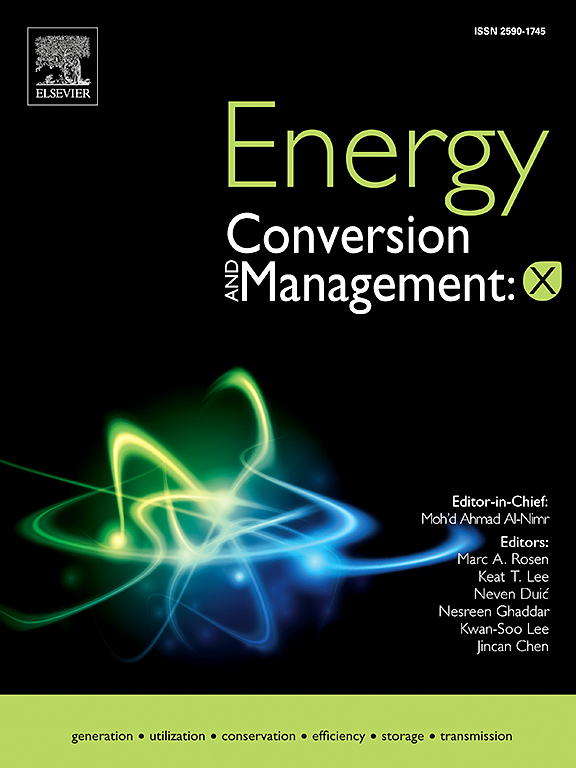Design and assessment of an integrated PV-based hydrogen production facility
IF 9.9
1区 工程技术
Q1 ENERGY & FUELS
引用次数: 0
Abstract
This study develops a photovoltaic (PV)-based hydrogen production system specifically designed for university campuses, which is expected to lead in sustainability efforts. The proposed system aims to meet the electricity demand of a Hydrogen Research Center while supplying energy to an electric charging station and a hydrogen refueling station for battery-electric and fuel-cell electric vehicles operating within the campus. In this integrated system, the electricity generation capacity of PV panels installed on the research center’s roof is determined, and the surplus electricity, after meeting the energy demand, is allocated to cover the varying proportions needed for both electric charging station and hydrogen production system. The green hydrogen produced by the system is compressed to 100, 350 and 700 bar, with intermediate cooling stages where the heat generated at the compressor outlet is absorbed by a cooling fluid and repurposed in a condenser for domestic hot water production. A full thermodynamic analysis of this entirely renewable energy-powered system is conducted by considering a 9-hour daily operational period from 8:00 AM to 5:00 PM. The average incoming solar radiation is determined to be 484.63 W/m2, resulting in an annual electricity generation capacity of 494.86 MWh. Based on the assumptions and data considered, the energy and exergy efficiencies of the proposed system are calculated as 17.71 % and 17.01 %, respectively, with an annual hydrogen production capacity of 3.642 tons. Various parametric studies are performed for varying solar intensity values and PV surface areas to investigate how the overall system capacities and efficiencies are affected. The results show that an integration of hydrogen production systems with solar energy offers significant advantages, including mitigating intermittency issues found in standalone renewable systems, reducing carbon emissions compared to fossil-based alternatives, and enhancing the flexibility of energy systems.
基于pv的一体化制氢设施的设计与评估
本研究开发了一个专门为大学校园设计的基于光伏(PV)的制氢系统,预计将引领可持续发展的努力。该系统旨在满足氢研究中心的电力需求,同时为校园内运行的电池电动汽车和燃料电池电动汽车的充电站和氢燃料补给站提供能源。在这个集成系统中,安装在研究中心屋顶的光伏板的发电能力被确定,剩余的电力在满足能源需求后被分配,以满足充电站和制氢系统所需的不同比例。该系统产生的绿色氢被压缩到100、350和700巴,在中间冷却阶段,压缩机出口产生的热量被冷却液吸收,并在冷凝器中重新利用,用于生产生活热水。对这个完全可再生能源供电的系统进行了全面的热力学分析,并考虑了每天从早上8点到下午5点的9小时运行周期。确定太阳平均入射辐射为484.63 W/m2,年发电量为494.86 MWh。根据所考虑的假设和数据,计算出该系统的能量效率为17.71%,火用效率为17.01%,年制氢能力为3.642吨。对不同的太阳强度值和PV表面积进行了各种参数研究,以研究如何影响整个系统的容量和效率。结果表明,氢气生产系统与太阳能的集成具有显着的优势,包括减轻独立可再生能源系统中存在的间歇性问题,与化石燃料替代品相比减少碳排放,并增强能源系统的灵活性。
本文章由计算机程序翻译,如有差异,请以英文原文为准。
求助全文
约1分钟内获得全文
求助全文
来源期刊

Energy Conversion and Management
工程技术-力学
CiteScore
19.00
自引率
11.50%
发文量
1304
审稿时长
17 days
期刊介绍:
The journal Energy Conversion and Management provides a forum for publishing original contributions and comprehensive technical review articles of interdisciplinary and original research on all important energy topics.
The topics considered include energy generation, utilization, conversion, storage, transmission, conservation, management and sustainability. These topics typically involve various types of energy such as mechanical, thermal, nuclear, chemical, electromagnetic, magnetic and electric. These energy types cover all known energy resources, including renewable resources (e.g., solar, bio, hydro, wind, geothermal and ocean energy), fossil fuels and nuclear resources.
 求助内容:
求助内容: 应助结果提醒方式:
应助结果提醒方式:


